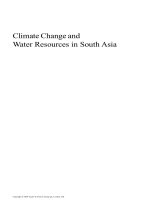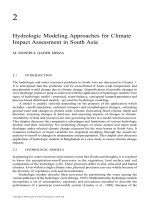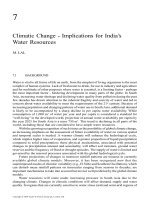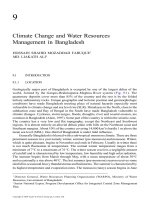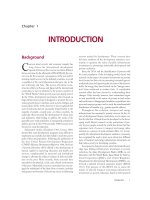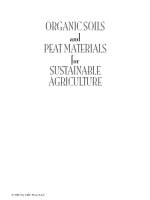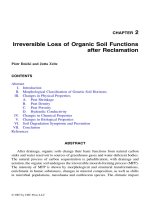ORGANIC SOILS and PEAT MATERIALS for SUSTAINABLE AGRICULTURE - CHAPTER 1 doc
Bạn đang xem bản rút gọn của tài liệu. Xem và tải ngay bản đầy đủ của tài liệu tại đây (299.58 KB, 25 trang )
ORGANIC SOILS
and
PEAT MATERIALS
for
SUSTAINABLE
AGRICULTURE
© 2003 by CRC Press LLC
CRC PRESS
Boca Raton London New York Washington, D.C.
ORGANIC SOILS
and
PEAT MATERIALS
for
SUSTAINABLE
AGRICULTURE
Edited by
Léon-Etienne Parent
Piotr Ilnicki
© 2003 by CRC Press LLC
Cover photograph courtesy of Léon-Etienne Parent
This book contains information obtained from authentic and highly regarded sources. Reprinted material
is quoted with permission, and sources are indicated. A wide variety of references are listed. Reasonable
efforts have been made to publish reliable data and information, but the authors and the publisher cannot
assume responsibility for the validity of all materials or for the consequences of their use.
Neither this book nor any part may be reproduced or transmitted in any form or by any means, electronic
or mechanical, including photocopying, microfilming, and recording, or by any information storage or
retrieval system, without prior permission in writing from the publisher.
All rights reserved. Authorization to photocopy items for internal or personal use, or the personal or
internal use of specific clients, may be granted by CRC Press LLC, provided that $1.50 per page
photocopied is paid directly to Copyright Clearance Center, 222 Rosewood Drive, Danvers, MA 01923
USA. The fee code for users of the Transactional Reporting Service is ISBN 0-8493-1458-
5/03/$0.00+$1.50. The fee is subject to change without notice. For organizations that have been granted
a photocopy license by the CCC, a separate system of payment has been arranged.
The consent of CRC Press LLC does not extend to copying for general distribution, for promotion, for
creating new works, or for resale. Specific permission must be obtained in writing from CRC Press LLC
for such copying.
Direct all inquiries to CRC Press LLC, 2000 N.W. Corporate Blvd., Boca Raton, Florida 33431.
Trademark Notice: Product or corporate names may be trademarks or registered trademarks, and are
used only for identification and explanation, without intent to infringe.
Visit the CRC Press Web site at www.crcpress.com
© 2003 by CRC Press LLC
No claim to original U.S. Government works
International Standard Book Number 0-8493-1458-5
Library of Congress Card Number 2002022951
Printed in the United States of America 1 2 3 4 5 6 7 8 9 0
Printed on acid-free paper
Library of Congress Cataloging-in-Publication Data
Organic soils and peat materials for sustainable agriculture / edited by Léon-Etienne
Parent, Piotr Ilnicki.
p. cm.
Includes bibliographical references and index.
ISBN 0-8493-1458-5 (alk. paper)
1. Histosols. 2. Peat soils. 3. Sustainable agriculture. I. Parent, Léon-Etienne. II.
Ilnicki, Piotr.
S598 .O725 2002
631.4¢17—dc21 2002022951
© 2003 by CRC Press LLC
Dedication
To the memory of Professor Henryk Okruszko (1925–2000),
Research Soil Scientist, Institute of Land Reclamation and Grassland
Farming (IMUZ) at Falenty, Poland, who described and documented
the moorsh-forming process as a generic soil concept for the
management of drained organic soils.
© 2003 by CRC Press LLC
Auspices Declaration
The International Peat Society, founded in Québec, Canada, in 1968, is a non-
governmental, nonprofit organization. Its mission is to promote wise use of mires,
peatlands, and peat by advancing scientific, technical, economic, and social knowl-
edge and understanding.
The members are involved in the study and use of peat, for instance, in agricul-
ture, forestry, horticulture, energy, chemical technology, environmental protection,
balneology, medicine, and related areas. Therefore, they explore a broad range of
peat-related issues.
Research institutes, commercial companies, government, nongovernment orga-
nizations, as well as private individuals form a unique base not only for information
exchange concerning the role of peatlands in the world’s geology, hydrology, climate,
and ecology, but also for their wise and sustainable utilization.
To promote knowledge and cooperation among its members, the International
Peat Society organizes international congresses, symposia, and workshops and pro-
vides several publications, such as the International Peat Journal. The Secretariat
of the International Peat Society is located in Jyväskylä, Finland.
International Peat Society
Jyväskylä, Vapaudenkatu 1240100
Finland
Tel. +358 14 3385 440
Fax. + 358 14 3385 410
ips@peatsociety.fi
© 2003 by CRC Press LLC
Foreword
The Ramsar Convention defined the wise use of peatlands as “their sustainable
use for the benefit of mankind in a way compatible with the maintenance of the
natural properties of the ecosystem.” Land sustainability relates to definite periods
and land uses. According to the International Peat Society (IPS) and the International
Mire Conservation Group (IMCG), the wise use of peatlands in forestry and agri-
culture should include careful land-use planning and water management sustaining
socioeconomic development in rural areas and preservation of flora and fauna (Peat-
lands International 2/1998: 25). Therefore, peatland management must account for
unacceptable ecological impacts on the contiguous and global environment. It is
well recognized that unsuitable practices must be alleviated within a relatively short
timeframe (i.e., a few years). This book, initiated during the IPS Congress held in
Bremen in 1996 by an international working group of IPS Commission III, is an
attempt to define organic soil quality attributes leading to a wiser soil management
in peatlands used for agriculture.
Irreversible processes occurring in drained organic soils must be managed cau-
tiously. The moorsh-forming process is the main step in the degradation of organic
soil materials, driving the physical deformation of peat colloids, peat decomposition
and related processes such as CO
2
production, organic N and P mineralization,
nitrification and denitrification, as well as the leaching of inorganic phosphate,
nitrate, and soluble carbon. Those processes are at risk to the contiguous and global
environment, and must be constrained during the short-living exploitation of organic
soils. There are many scientific and technical reports indicating significant contri-
bution of drained organic soils to off-farm water pollution by nitrate, phosphate and
soluble C, and to greenhouse gas emissions, primarily as CO
2
and N
2
O. On the other
hand, organic soils contribute greatly to the production of food and ornamental plants
to the benefit of mankind. The authors hope that this book will prompt action in the
field and stimulate research for the wise management of organic soils and peat
materials, shifting the present paradigm of input-based and unsustainable use to the
modern paradigm of knowledge-based and sustainable agriculture and horticulture.
The authors collected up-to-date information in order to define quality indicators
for the optimum use of organic soils in the agricultural and horticultural productions.
The soil quality attributes make up its pedigree (from the French expression pied-
de-grue or crane foot, meaning the three typical traits of a thing — living or
nonliving, similarly to a crane footprint). The soil pied-de-grue is documented
through its physical, chemical and biological attributes. Soil quality can be assessed
both quantitatively or qualitatively. Soil quality is related to sustainable productivity,
and to its limited capacity to act as an environmental buffer. Soil buffering capacity,
as related to organic matter content and pH, comprises resistance to carbon, nitrogen,
and phosphorus release, as well as water, pesticide, and metal retention. Soil con-
servation practices include water regulation, crop cover, fertilization, and liming, as
well as soil restoration after peat wastage or cutting.
This book is composed of 10 chapters: the characteristics of organic soil genesis
and degradation, (Chapter 1), the irreversible peat drying in drained organic soils
© 2003 by CRC Press LLC
(Chapter 2), the physical attributes required for the water management of organic
soils (Chapter 3) and peat substrates (Chapter 4), pH determination and correlation
among methods (Chapter 5), the N and P pollution indicators (Chapter 6), Cu
sorption (Chapter 7), pesticide reactions (Chapter 8), cultivation of cutover peatlands
(Chapter 9), and conservation of organic soils (Chapter 10). The book covers a large
spectrum of organic soil materials used in situ or in containers.
Léon E. Parent, chairman of the IPS-WG
Department of Soil Science and Agri-Food Engineering
Laval University, Québec, Canada G1K 7P4
© 2003 by CRC Press LLC
The Editors
Dr. Léon Etienne Parent received his Ph.D.
in soil fertility from McGill University, Montreal,
Canada. He is a member of the Soil Science Soci-
ety of America, the Canadian Soil Science Soci-
ety, the International Soil Science Society, and the
International Peat Society (IPS). He has chaired
the Histic Soil Quality Working Group of IPS
since 1996. He has authored or coauthored over
60 peer-reviewed articles, more than half related
to organic soils and peat substrates. He has also
contributed to seven book chapters and technical
papers on organic soils. His major contributions
to organic soil science concern soil transforma-
tions after drainage, agricultural capability clas-
sification, crop rotation and nutrient diagnosis, as well as the use of peat as a mineral
soil amendment and as a source of humic substances for enhancing phosphorus
fertilizer efficiency in mineral soils.
Dr. Piotr Ilnicki received his Ph.D. in soil science
from the Agricultural University in Szczecin, Poland.
He is a former vice-president of the International Peat
Society (IPS), and president of Commission III of IPS
(agriculture) and of the Polish National Committee of
IPS. He is member of the Polish Soil Science Society
and of the International Association for Landscape
Ecology. He has authored or coauthored more than 70
peer-reviewed articles. He also edited a Polish hand-
book on peatlands and peat.
© 2003 by CRC Press LLC
Contributors
Tomasz Brandyk
Department of Environmental
Development and Land Improvement
Warsaw Agricultural University
Warsaw, Poland
Jean Caron
Department of Soil Science and
Agri-Food Engineering
Laval University
Québec, Canada
Caroline Côté
Institut de Recherche et de
Développement en Agro-
Environnement (IRDA)
Saint-Hyacinthe, Québec, Canada
Josée Fortin
Department of Soil Science and Agri-
Food Engineering
Laval University
Québec, Canada
Tomasz Gnatowski
Department of Environmental
Development and Land Improvement
Warsaw Agricultural University
Warsaw, Poland
Piotr Ilnicki
Department of Environmental
Protection and Management
Agricultural University
Poznan, Poland
Antoine Karam
Department of Soil Science and
Agri-Food Engineering
Laval University
Québec, Canada
Lotfi Khiari
Department of Soil Science and
Agri-Food Engineering
Laval University
Québec, Canada
Vera N. Kreshtapova
Dokutchaev Soil Science Institute
Moscow, Russia
Rudolf A. Krupnov
Tver State Technical University
Tver, Russia
Henryk Okruszko
Institute of Land Reclamation and
Grassland Farming
Falenty, Poland
Ryszard Oleszczuk
Department of Environmental
Development and Land Improvement
Warsaw Agricultural University
Warsaw, Poland
Léon E. Parent
Department of Soil Science and
Agri-Food Engineering
Laval University
Québec, Canada
Louis-Marie Rivière
Unité Mixte de Recherches
Sciences Agronomiques Appliquées à
l’Horticulture
Institut National de la Recherche
Agronomique
Institut National d’Horticulture
Beaucouzé, France
© 2003 by CRC Press LLC
Jan Szatylowicz
Department of Environmental
Development and Land Improvement
Warsaw Agricultural University
Warsaw, Poland
Catherine Tremblay
Department of Soil Science and
Agri-Food Engineering
Laval University
Québec, Canada
Olga N. Uspenskaya
Dokutchaev Soil Science Institute
Moscow, Russia
Jutta Zeitz
Institute of Crop Sciences
Faculty of Agriculture and Horticulture
Humboldt University
Berlin, Germany
© 2003 by CRC Press LLC
Contents
Chapter 1
The Moorsh Horizons as Quality Indicators of Reclaimed Organic Soils
Henryk Okruszko and Piotr Ilnicki
Chapter 2
Irreversible Loss of Organic Soil Functions after Reclamation
Piotr Ilnicki and Jutta Zeitz
Chapter 3
Water-Related Physical Attributes of Organic Soils
Tomasz Brandyk, Jan Szatylowicz, Ryszard Oleszczuk, and Tomasz Gnatowski
Chapter 4
Quality of Peat Substrates for Plants Grown in Containers
Jean Caron and Louis-Marie Rivière
Chapter 5
Soil Acidity Determination Methods for Organic Soils and Peat Materials
Léon E. Parent and Catherine Tremblay
Chapter 6
Nitrogen and Phosphorus Balance Indicators in Organic Soils
Léon E. Parent and Lotfi Khiari
Chapter 7
Retention of Copper in Cu-Enriched Organic Soils
Antoine Karam, Caroline Côté, and Léon E. Parent
Chapter 8
Fate of Pesticides in Organic Soils
Josée Fortin
Chapter 9
Quality of Organic Soils for Agricultural Use of Cutover Peatlands
in Russia
Vera N. Kreshtapova, Rudolf A. Krupnov, and Olga N. Uspenskaya
Chapter 10
Agricultural Production Systems for Organic Soil Conservation
Piotr Ilnicki
© 2003 by CRC Press LLC
CHAPTER
1
The Moorsh Horizons as Quality Indicators
of Reclaimed Organic Soils
Henryk Okruszko and Piotr Ilnicki
CONTENTS
Abstract
I. Introduction
II. Organic Soil Classification
III. Moorsh Formation
IV. Soil Morphology as an Indicator of Organic Soil Quality
V. Prognostic Soil Moisture Complexes (PSMC) as Related to
Organic Soil Quality
VI. Conclusion
References
ABSTRACT
In Poland, drained mires are called peatlands. After reclamation, organic soils,
primarily those originating from fens undergo genetical transformations designated
globally as the moorsh-forming process (MFP). The intensity of MFP is monitored
by changes in soil morphology and structure such as peat transforming into grains
and aggregates, thus altering physical properties. The descriptive criteria for those
transformations are as follows:
• Three diagnostic horizons (moorsh layers M
1
to M
3
in the 0–30 cm root zone,
peat layers T
1
in the 30–80 cm vadose zone, and peat layers T
2
in the 80–130 cm
zone of lateral groundwater flow)
• Three genetic layers in the vertical sequence M
1
to M
3
(M
1
as grain moorsh in
the sod, M
2
as humic moorsh, and M
3
as peaty moorsh above peat layers)
© 2003 by CRC Press LLC
• Three stages of MFP development (I, II, and III) in the moorsh layers; and three
degrees of peat decomposition (a for fibric, b for hemic, and c for sapric materials)
for T
1
and T
2
For water management, five prognostic soil moisture complexes are recognized
from those criteria: wet (A), periodically wet (AB), moist (B), periodically dry (BC),
and dry (C). Irrigation and water table regulation must be carefully designed for
improving soil quality in BC and C complexes.
I. INTRODUCTION
In Poland, a wetland showing peat accumulation is designated as a mire for
undrained, or as a peatland for drained, conditions. Mires are further classified
according to trophic levels into fens, transitional bogs, and raised bogs. Organic soils
are concerned with two major soil processes: paludification for peat accumulating
under waterlogged conditions, and decession with moorsh forming and peat miner-
alization occurring after drainage and reclamation of the former mire ecosystem.
Polish soils are classified as organic if the upper layer contains organic materials
thicker than 30 cm, where roots proliferate. Below the root layer, organic soils are
further divided according to the thickness of organic materials into shallow (30–80
cm), moderate (80–130 cm), and deep (>130 cm) soils, as well as the nature of the
underlying mineral material (Okruszko, 1994). The paludic soils, coded “Pt,” char-
acterize peat accumulated in fen, transitional, or bog mire ecosystems. Peat drying
and aeration result in the loss of organic substances, and typical soil morphology
throughout the organic soil profile. Transformation of the peat materials into post-
paludic soils is designed as the MFP (from the Polish name murszenie), which is
similar to, but more documented than, the muck-forming process (Okruszko, 1960,
1993; van Heuveln et al., 1960; Pons, 1960; Skrynnikova, 1961; Illner, 1977; Schmidt
et al., 1981; Zeitz, 1992; Sponagel et al., 1996). The post-paludic soils, coded “Mt,”
are classified according to the stage of MFP. The moorsh intensity factor is a soil
quality indicator for water management (Tomaszewski, 1950; Okruszko, 1960).
Proper water management is required not only to fulfill crops’ needs, but also to slow
down soil subsidence and thus sustain the productive life of cultivated organic soils.
The aim of this chapter is to present the organic soil classification system used
in Poland, and the moorsh intensity factor as a quality indicator of reclaimed
organic soils.
II. ORGANIC SOIL CLASSIFICATION
In soil classification systems (Agriculture Canada, 1992; Soil Survey Staff, 1996;
Schwerdtfeger, 1996; Marcinek, 1997; Sauerbrey and Zeitz, 1999), organic soils are
characterized by a histic horizon (Table 1.1), and are genetically related to gleysols
(Table 1.2). In Poland, organic soil materials may be peat, mud, mud-peat or gyttja
(Table 1.2), depending on the origin of parent materials (Tolpa et al., 1967), as well
© 2003 by CRC Press LLC
as its organic matter content (OMC) (Zawadzki, 1970) and humification degree
(Okruszko, 1993). Organic soil materials must show more than 20% OMC. The
botanical origin of the peat (Table 1.3), its ash content, and the degree of peat decom-
position (Tables 1.4 and 1.5) confer many quality attributes to the soil such as OMC,
bulk density, and volume of the solid phase (Tables 1.6 and 1.7) (Ilnicki, 1967;
Table 1.1 Symbols for Histic Horizons in Different Soil
Classification Systems
Histic Horizon FAO
a
USA Germany England Russia
Peaty or histic
Raised bog
Transitional bog
Fen
Ploughed
H
H
i
H
e
H
a
H
p
O
O
i
O
e
O
a
O
p
H
hH
üH
nH
Hp
O
O
f
O
m
O
h
O
p
T
T
1
T
2
T
3
T
A
a
Food and Agriculture Organization.
Source: From Schwaar J. and Schwerdtfeger, G. 1992. Proc. 9th Int.
Peat Congr., Uppsala, Sweden,1:40–45. With permission.
Table 1.2
Comparison between Organic Soil Classification Systems
Polish Classification
(1989)
World Reference Base
(1994)
FAO-Revised Legend
(1990)
IV. HYDROGENIC
IV A. Paludic soils
IV A1. Mud
IVA1a – typic
IVA1b – peaty
IVA1c – gyttja
Eutri – Haplic Organic soils
Eutri – Haplic Organic soils
Eutri – Haplic Organic soils
Dystri – Haplic Organic soils
Hss, Terric Organic soils
Hss, Terric Organic soils
Hss, Terric Organic soils
Hss, Terric Organic soils
IV A2. Peat
IVA2a – fen
IVA2b – transition bog
IVA2c – raised bog
Eutri – Haplic Organic soils
Dystri – Haplic Organic soils
Fibric Organic soils
Eutri-Hss, Eutri-Terric Organic
soils, HSt, Fibric Organic soils
Dystri-HSf, Dystri-Fibric Organic
soils
Dystri-HSf, Dystri-Fibric Organic
soils
IV B. Post-paludic soils
IV B1. Moorsh
IVB1a – peaty-moorsh
IVB1b – muddy-moorsh
IVB1c – gyttja-moorsh
IVB1d – overmoorsh
Eutri – Haplic Organic soils
Eutri – Haplic Organic soils
Eutri – Haplic Organic soils
Eutri – Haplic Organic soils
HSs, Terric Organic soils
HSs, Terric Organic soils
HSs, Terric Organic soils
HSs, Terric Organic soils
IV B2. Moorsh-like
IVB2a – mineral-moorsh
IVB2b – typic
IVB2c – moorshy (mucky)
Mollic Gleysols
Areni – Mollic Gleysols
Areni – Mollic Gleysols
Histi-GLm, Histi-Mollic Gleysols
Areni-GLm, Areni-Mollic Gleysols
Areno-GLm, Areni Mollic Gleysols
Source: From Marcinek, J. 1997. Proc. Comparison between Polish and German Soil Classi-
fication Systems, 13–40. With permission.
© 2003 by CRC Press LLC
Okruszko, 1971; Okruszko and Szymanowski, 1992). Muds are formed under periodic,
usually fluvial, flooding. Due to high variations in water level, deposited organic
materials are humified, enriched with mineral colloidal materials, and frequently silted.
Gyttja is a lacustrine sediment consisting of mineral particles (sand, silt, clay, rests of
diatoma, and snails), calcium carbonate, and organic matter (Ilnicki, 1979; Sponagel
et al., 1996). They are classified as locustrine chalk, calcareous, calcareous-organic,
calcareous mineral, mineral-organic, and organic (Table 1.8).
III. MOORSH FORMATION
The moorsh horizons were first described in the Polish soil classification system
(Polish Society of Soil Science, 1974), then in the German scheme. Soils resulting
from MFP were called muck soils in the United States, earthy peat soils in Great
Britain, and vererdete Torfböden in Germany and The Netherlands (Okruszko, 1998).
The German Soil Cartography Handbook uses the following terms for the moorsh
horizons of organic soils used as meadows (Sponagel et al., 1996): Torf-Vermulmu-
ngshorizont or peat-dust horizon, Torf-Vererdungshorizont or peat-aggregate horizon,
Table 1.3 Botanical Peat Classification
Type Subtype Name
Fen I. Potamioni 1. Tyrfopel
II. Limno-Phragmitioni
rush peat
2. Phragmiteti
3. Scirpo-Typhaeti
4. Equiseteti
5. Glycerieti
III. Magnocaricioni
tall sedge peat
6. Cariceto-Phragmiteti
7. Cariceti
8. Cladieti
IV. Bryalo-Parvocaricioni
sedge-moss peat
9. Bryaleti
10. Cariceto-Bryaleti
11. Gramino-Cariceti
V. Alnioni
alder peat
12. Saliceti
13. Alneti
14. Alno-Betuleti
Transition bog VI. Minero-Sphagnioni
sedge-sphagnum peat
15. Sphagno-Scheuchzerieti
16. Sphagno-Cariceti
VII. Betulioni
birch peat
17. Betuleti
Raised bog VIII. Ombro-Sphagnioni
sphagnum moss peat
18. Cuspidato-Sphagneti
19. Eusphagneti
20. Eriophoro-Sphagneti
21. Pino Sphagneti
IX. Ericioni
heather peat
22. Ericaceti
23. Trichophoreti
X. Ledo-Pinioni
pine peat
24. Pineti
Peat, nonfibrous XI. Humotorf
sapric peat
Source: From Tolpa, S., Jasnowski, M., and Palczyski, A. 1967. Zeszyty Prob-
lemowe Postepow Nauk Rolniczych, 76:9–99. With permission.
© 2003 by CRC Press LLC
Table 1.4
Peat Classification According to Degree of Decomposition
R Degree Structure of Peat Presence of Humus Amount of Water
R
1
fibric (a)
Spongy or fibrous, occasionally compacted,
felty.
None or very little humus, as dispersed dark
mass saturating and coloring plant remains.
Large amount of water, easily trickles out,
usually almost clear or only slightly brown in
color, may contain dark particles of humus.
R
2
hemic (b)
Fibrous- to clody-amorphous, visible fine
fibres in humus; peat almost non-elastic
after water extraction. Large fragments
made of reed or woody remains, crushed
between fingers into an amorphous mass.
Humus flowing with water or oozing between
fingers and forming less than 1/3 of peat
mass.
In paludic sites water oozes in sparse drops
or trickles down as a thick, greasy fluid
darkened by humus; in drying peat sites,
water is slightly colored by humus and may
not be used to determine the degree of
decomposition.
R
3
sapric (c)
Amorphous structure; dark, homogeneous
mass sporadically interspersed with coarser
plant remains (wood, reed).
Humus oozing between fingers, comprising
at least half of the peat.
Water may not be extracted from peat; mainly
humus is extracted.
Source: From Okruszko, H. 1994. Bibl. Wiadomosci Instytutu Melioracji i Uzytk
ow Zielonych, 84:5–27. With permission.
© 2003 by CRC Press LLC
Table 1.5 Comparison between Determination Methods for Degree of Peat Decomposition
Von Post
Degree
USSR
Humification
Degree R
Rubbed Fiber Content Germany
No. in DIN
19682/12
Poland
Humification
Degree RASTM USDA-FAO Canada
1R
1
Fibric Fibric Fibric 1 R
1
2R
2
Hemic
32
4 Hemic Mesic R
2
5R
3
Sapric 3
6 Sapric
74R
3
8 Humic
95
10
Source: From Malterer, T.J., Verry, E.S., and Erjavec, J. 1992. Proc. 9th Int. Peat Congr., Uppsala,
Sweden, 1:310–318. With permission.
Table 1.6
Typical Ranges of Physical Properties of Peat Materials
Type
Most Frequent Occurrence
Humification
Degree R
Loss on Ignition
(kg kg
–1
)
Bulk Density
(g cm
–3
)
Volume of Solids
(%) (m
3
m
–3
)
Reed peat
Tall sedge peat
Sedge-moss peat
Alder peat
Sedge-Sphagnum peat
Sphagnum peat
R
2
R
3
R
1
R
2
R
3
R
1
R
2
R
2
R
3
R
2
R
1
0.60–0.90
0.75–0.90
0.85–0.95
0.70–0.85
0.80–0.95
0.97–0.99
0.15–0.25
0.10–0.18
0.09–0.13
0.16–0.22
0.12–0.17
0.06–0.10
0.08–0.11
0.07–0.10
0.06–0.08
0.10–0.13
0.07–0.10
0.04–0.06
Source: From Ilnicki, P. 1967. Zeszyty Problemowe Postepow Nauk Rolniczych, 76:197–311.
With permission.
Table 1.7 Typical Physical Properties of Fen Peat Materials as Related to Degree
of Decomposition
Degree
Observations
No.
Ash
(kg kg
–1
)
Bulk
Density
(g cm
3
) Porosity
Moisture Content
(m
3
m
–3
)
pF
a
2.0 pF 2.7 pF 4.2
R
1
138 0.084 0.114 0.927 0.665 0.396 0.132
R
2
171 0.114 0.141 0.912 0.715 0.496 0.195
R
3
177 0.151 0.175 0.893 0.686 0.527 0.252
a
pF = log
10
(y
M
), where y
M
is the matric potential in centimeters.
Source: From Okruszko, H. and Szymanowski, M. 1992. Proc. 9th Int. Peat Congr., Uppsala,
Sweden, 3:106–115. With permission.
© 2003 by CRC Press LLC
and Torf-Bröckelhorizont or peat-lump horizon. Such distinctions were not made in
North America, where frequent tillage operations for arable farming admix moorsh
horizons. Typically, moorsh thickness is less than 35 cm.
In organic soils, fissures generally start forming at 65% (v/v) moisture content
and 70% in the case of alder peat. The Sphagnum and sedge-moss fibric peat materials
only shrink and do not crack, thus slowing down MFP (Ilnicki, 1967). In practice,
MFP develops only in drained fen mires, which make up over 90% of Polish peatlands.
As a result of shrinking and swelling, the original peat structure changes into a moorsh
structure (Okruszko, 1994). The moorsh grainy or granular structure consists of:
1. Soil aggregates, 5 to 10 mm in diameter, mostly hydrophobic, highly porous, and
often made of worm casts
2. Particles not exceeding 4 mm in diameter, highly susceptible to wind erosion, and
breaking down easily into smaller fragments
Three moorsh horizons with typical morphological features are recognized in
organic soils under permanent grass: M
1
as grainy moorsh in the sod or turf layer
and, down the profile, M
2
as humic moorsh, and M
3
as peaty moorsh overlying peat
materials (Table 1.9). Compared with original peat materials, moorsh materials show
Table 1.8 Chemical Composition of Gyttja Materials
in Poland
Gyttja Material
CaCO
3
Content
(g kg
–1
)
Ash Content
(g kg
–1
)
Organic gyttja < 200 < 600
Organic-mineral gyttja < 200 600–800
Mineral gyttja < 200 800–1000
Organic-calcareous gyttja 200–600 200–600
Mineral-calcareous gyttja 200–400 600–1000
Calcareous gyttja 400–800 600–1000
Lacustrine chalk 800–1000 800–1000
Source: From Ilnicki, P. 1979. Proc. Polish Soc. Earth Sci. Conf.,
73–78. With permission.
Table 1.9
General Characteristics of Moorsh Horizons
Horizon Name Morphology
M
1
Sod layer:
grainy moorsh
Soil mass intermingled with plant roots, structure ranging from
amorphous, granular to fine-grained, dust-like. In arable soils,
the structure is usually uniform throughout the cultivated layer.
M
2
Subsod layer:
humic moorsh
Soil mass characterized by grainy, less frequently granular,
relatively loose structure. Soil grains almost exclusively made
of compacted humus, their size, between 2–4 mm, gradually
increases down the profile to granules 5–10 mm in size.
M
3
Transition layer:
peaty moorsh
Soil mass with a peat structure subjected to the moorsh-forming
process primarily due to shrinking and swelling leading to the
formation of lumps often becoming visible under pressure. The
lumps are cemented by humus, frequently leached from
overlying layers. Several fissures.
Source: From Okruszko, H. 1994. Bibl. Wiadomosci Instytutu Melioracji i Uzytkow Zielonych,
84:5–27. With permission.
© 2003 by CRC Press LLC
15–20% higher ash content, 0.2–0.3 g cm
-3
higher bulk density, and smaller porosity
(Table 1.10). The retention of plant available water is considerably reduced in grainy
moorsh compared with original peat materials (Table 1.10), whereas hydraulic con-
ductivity is highest and capillarity rise is lowest in the grainy moorsh compared with
original peat materials. The thicker the grainy moorsh horizon (M
1
), the lower the
soil quality is. The M
3
horizon may include a 5- to 10-cm thick degraded layer of
coke-like peat materials made of hard, small, and irreversibly dried particles (Figure
1.1), indicating markedly reduced soil quality.
IV. SOIL MORPHOLOGY AS AN INDICATOR OF ORGANIC
SOIL QUALITY
The soil profile is divided into peat and moorsh horizons (Table 1.11). Three
layers are examined to assess soil processes across a 130-cm deep soil profile
(Okruszko, 1994):
Table 1.10 Typical Porosity of Basic Moorsh Types
Type
(Layer)
Total
Porosity
m
–3
Macroporosity
pF < 2.0
m
–3
Mesoporosity (m
3
m
–3
)
Microporosity
pF > 4.2
m
–3
pF 2.0–4.2
m
–3
pF 2.0–2.7
m
–3
Grainy (M
1
)
Humic (M
2
)
Peaty (M
3
)
0.825
0.830
0.885
0.249
0.172
0.161
0.291
0.382
0.507
0.122
0.186
0.257
0.285
0.276
0.217
Source: From Okruszko, H. 1976. Zeszyty Problemowe Postepow Nauk Rolniczych,
177:159–204. With permission.
Figure 1.1 Organic soil profiles at four developmental stages of the moorsh-forming process.
(Adapted from Okruszko, H. 1967. Zeszyty Problemowe Postepow Nauk Rolni-
czych, 72:13–27. With permission).
0
10
20
30
40
50
60
70
0
10
20
30
40
50
60
70
M
1
M
2
MCoke layer
3
T
Mt I
Mt III
degraded
Degradation sequence
Average depth of groundwater table cross vegetation period
Depth below soil surface (cm)
Mt II
Mt III
© 2003 by CRC Press LLC
1. 0–30 cm: attributes of the root layer (K), primarily water retention capacity
2. 30–80 cm: attributes of the underlying layer (T
1
) such as water storage capacity
and capillary rise for transferring water from water table to the root zone
3. 80–130 cm: the lower layer (T
2
) affecting lateral water movement connected with
drainage ditches or groundwater flow
The soil process is identified as P for paludic soils in mire ecosystems, or M for
moorsh or post-paludic soils in peatlands. Mire paludification degree is designed
from the degree of peat decomposition as fibric (III), hemic (II), and sapric (I) peat
materials. The symbol “t” originates from the Polish and German word Torf (peat).
In general, highly paludified soils (PtIII) (i.e., fibric peat materials) change into low-
degree moorsh (MtI), while slightly to moderately paludified soils (PtI to PtII) change
into medium-degree moorsh (MtII). The thickness of genetic moorsh horizons qual-
ifies MFP by degradation stage (Figure 1.1). The intensity of MFP (I to III in the
ascending order of peat degradation rate) depends on thickness of the M
1
-M
2
-M
3
horizon sequence in K (Tables 1.9 and 1.12). The three degrees of decomposition
in T
1
(30–80 cm) are: a for fibric peat, b for hemic peat, and c for sapric peat. Soil
notation then becomes, for example, MtIIb. Layer T
2
(80–130 cm) is described as
layer T
1
, for example, MtIIbc. These rules are extended to deeper layers (>130 cm).
Polish fen soils are typically thicker than 80 cm. In moderately deep soils
(80–130 cm), mineral layers underlying peat should be characterized for grain-size
distribution (Table 1.13). For example, a moderately deep organic soil may be coded
as MtIIb2.
V. PROGNOSTIC SOIL MOISTURE COMPLEXES (PSMC) AS RELATED
TO ORGANIC SOIL QUALITY
After organic soil reclamation, capillary rise supplying water to the roots is
related to peat structure. Many soil types from various combinations of diagnostic
horizons (Okruszko, 1977, 1994) were grouped in prognostic soil moisture com-
plexes (PSMC). For managing Polish fen soils under grassland farming, five PSMCs
were named after typical water regimes as wet (A), periodically wet (AB), moist
(B), periodically dry (BC), and dry (C). Soil types in each PSMC are assumed similar
in water regime and agricultural use as shown in Table 1.14 (Szuniewicz, 1994).
Table 1.11 Scheme for Describing a Moorsh Soil Profile
Diagnostic Layer Classification
K (0–30 cm)
T
1
(30–80 cm)
T
2
(80–130 cm)
Soil group as paludic Pt or moorsh Mt, then as
PtT-II-III or MtI-II-III (Table 1.12)
Soils are classified: a, b, c (Table 1.4)
Soils are classified as (Tables 1.4 and 1.13):
aa-ab-ac or a1-a2-a3-a4
ba-bb-bc or b1-b2-b3-b4
ca-cb-cc or c1-c2-c3-c4
Source: From Okruszko, H. 1998. J. Water Land Dev., 2:63–73. With
permission.
© 2003 by CRC Press LLC
The wet complex (A) occurs in slightly decomposed sedge-moss peat and
represents areas receiving a liberal groundwater supply. Due to the fibrous peat
structure conferring high capillary rise, the soil is moist even when the groundwater
level is 100 cm below surface. After drainage, they change slowly during the first
moorsh stage (MtI). The rate of decomposition is slow due to low available N. The
periodically wet complex (AB) resembles the A complex: the fibric sedge-moss
peat overlies hemic, usually tall sedge peat, resulting in lower capillary rise and
leading to smaller moisture acquisition by the roots in periods of intensive evapo-
transpiration.
The moist complex (B) occurs in hemic, usually tall sedge peat deposits, occa-
sionally showing fibric peat in deeper sections of the profile. Due to high volume
of mesopores, sufficient moisture is available for grass growth if the groundwater
table is lowered no deeper than 80 cm. After several years of drainage and droughts,
capillary rise and water retention capacity decrease.
The periodically dry complex (BC) develops on soils formed from hemic or
fibric peat materials overlying sapric peat, mud, or gyttja, as well as medium- to
heavy-textured mineral soil materials. By lowering the groundwater table, the surface
layers may become too dry to sustain grass growth. Organic materials undergo
intensive MFP and release high amounts of mineral N. The drying complex (C) is
associated with shallow soils developed from sapric peat overlying light- or heavy-
textured soil materials. The soil becomes too dry in the summer without supplemen-
tary irrigation, because water level is too low for effective capillary rise.
Table 1.12 Stage of Soil Degradation Due to the Moorsh-forming Process
Stage
Genetic
Layers
Thickness of
the Moorsh Features of the Moorsh
MtI (initial) M
1
M
2
beginning
<20 cm Usually poor granulation, M
1
strongly
bound by roots, peat fibres in the moorsh
MtII
(intermediate)
M
1
and M
2
M
3
beginning
20–30 cm Thick moorsh, abrupt transition from
moorsh to underlying parent material, no
well-defined M
3
MtIII (final) M
1
, M
2
and
M
3
>30 cm Well-defined M
3
with coarse, prismatic or
fissured structure, dehydration under the
root zone
Source: From Okruszko, H. 1994. Bibl. Wiadomosci Instytutu Melioracji i Uzytkow Zielonych,
84:5–27. With permission.
Table 1.13 Textural Classification of Mineral Soils
in Poland
Textural
Type Symbol Granulometric Classification
Very light
Light
Medium
Heavy
1
2
3
4
loose sand, slightly loamy sand
light loamy sand, heavy loamy sand
light loam, medium loam, silt
loamy silt, heavy loam, clay
Source: From Okruszko, H. 1998. J. Water Land Dev.,
2:63–73. With permission.
© 2003 by CRC Press LLC
Table 1.14 Classification of Prognostic Soil-Moisture Complexes in Peatlands under Grassland in Poland
Prognostic
Soil-Moisture
Complex
Thickness of Organic Soils
Thick (>130 cm)
Moderately Thick
(80–130 cm) Shallow (<80 cm)
A (wet) MtIaa
AB
(periodically wet)
MtIab
MtIba
MtIIaa
B (moist) MtIbb MtIIab
MtIIba
MtIIbb
MtIaa
MtIab
MtIba
MtIbb
MtIIaa MtIa3
BC
(periodically dry)
MtIac
MtIbc
MtIIac
MtIIbc
MtIIIba
MtIac
MtIbc
MtIIab
MtIIac
MtIIba
MtIIbb
MtIIbc
MtIa4
MtIb3
MtIIa3
MtIIb3
C (dry) MtIIca
MtIIcb
MtIIcc
MtIIIca
MtIIIbb
MtIIIbc
MtIIIcb
MtIIIcc
MtIIca
MtIIcb
MtIIcc
MtIIIba
MtIIIbb
MtIIIbc
MtIIIca
MtIIIcb
MtIIIcc
MtIa2
MtIa1
MtIb4
MtIb2
MtIb1
MtIIa4
MtIIa2
MtIIa1
MtIIb4
MtIIb2
MtIIb1
MtIIc3
MtIIc4
MtIIc2
MtIIc1
MtIIIb3
MtIIIb4
MtIIIb2
MtIIIb1
MtIIIc3
MtIIIc4
MtIIIc2
MtIIIc1
Source: From Okruszko, H. 1998. J. Water Land Dev., 2:63–73. With permission.
© 2003 by CRC Press LLC
The following reclamation and water management measures regulate air–water
conditions:
1. For A and AB, irrigation is not needed.
2. The B complex requires careful regulation of water outflow in order to keep water
easily available to the plant under the root zone, and to prevent degradation of
soil physical properties such as capillary rise and water retention capacity.
3. For the BC and C complexes, drainage and irrigation must be combined to regulate
water outflow for sites supplied by groundwater inflow. If groundwater inflow is
low, irrigation water is directed to the drainage system from reservoirs or streams.
If shallow organic soils are underlain by porous mineral substrate, the water level
is raised in the river to facilitate lateral water inflow through the permeable
substrate.
VI. CONCLUSION
The intensity of MFP taking place in drained organic soils is a valuable indicator
of soil quality. Strong moorsh development indicates degraded physical properties
and increased N mineralization potential. To describe MFP, the Polish soil classifi-
cation system defined three diagnostic layers (0–30, 30–80, 80–130 cm), three stages
of advancement of the moorsh-forming process in the root layer (I, II, III), three
characteristic genetic horizons (M
1
, M
2
, M
3
), and three peat decomposition degrees
(a, b, c) in the two underlying peat layers (T
1
and T
2
). Those physical and morpho-
logical indicators are used to classify soils. Soil types are further grouped into five
prognostic soil moisture complexes for managing the water resource in drained
organic soils (A, AB, B, BC, and C).
REFERENCES
Agriculture Canada. 1992. Canadian system of soil classification. (in French). Publ. 1646,
2nd Ed., Research Branch, Agriculture and Agri-Food Canada, Ottawa.
Illner, K. 1977. Soil genesis in fen peat. (in German). Archiv für Acker Pflanzenbau und
Bodenkunde, 21(12):867–782.
Ilnicki, P. 1967. Peat shrinkage by drying as related to structure and physical properties. (in
Polish with German summary). Zeszyty Problemowe Postepow Nauk Rolniczych,
76:197–311.
Ilnicki, P. 1979. Prospects for utilizing calcareous gyttja as commercial fertilizer. (in Polish).
Proc. Polish Soc. Earth Sci. Conf., 73–78, Kreda jeziorna i gytia, Lubniewice-Gorzów.
Malterer, T.J., Verry, E.S. and Erjavec, J. 1992. Peat classification in the relation to several
methods used to determine fiber content and degree of decomposition. Proc. 9th Int.
Peat Congr., 1:310–318, Uppsala, Sweden.
Marcinek, J. 1997. Principles of the Polish soil classification system. Proc. Comparison
between Polish and German Soil Classification Systems: 13–40, German Soil Sci.
Soc. and Polish Soil Sci. Soc., Szczecin, Poland.
© 2003 by CRC Press LLC
Okruszko, H. 1960. Moorsh soils of valley peatlands, and their chemical and physical prop-
erties. (in Polish with English summary). Roczniki Nauk Rolniczych, F 74.1: 5–89.
Okruszko, H. 1967. Soil properties in drained peatland. (in Polish with German summary).
Zeszyty Problemowe Postepow Nauk Rolniczych, 72:13–27.
Okruszko, H. 1971. Determination of specific gravity of hydrogenic soils on the basis of their
mineral particles content. (in Polish with English summary). Wiadomosci Instytutu
Melioracji i Uzytkow Zielonych, 10.1:47–54.
Okruszko, H. 1976. Impact of draining organic soils under Polish conditions. (in Polish with
English summary). Zeszyty Problemowe Postepow Nauk Rolniczych, 177:159–204.
Okruszko, H. 1977. Prognostic soil-moisture complexes in drained peatlands as criterion for
differentiating site conditions. (in Polish with English summary). Zeszyty Problemowe
Postepow Nauk Rolniczych, 186:49–66.
Okruszko, H. and Szymanowski, M. 1992. Correlation between bulk density and water-
holding capacity of fen peats. Proc. 9th Int. Peat Congr., 3:106–115, Uppsala, Swe-
den.
Okruszko, H. 1993. Transformation of a fen organic soil after drainage. Zeszyty Problemowe
Postepow Nauk Rolniczych, 406:3–73.
Okruszko, H. 1994. System for hydrogenic soil classification in Poland. Bibl. Wiadomosci
Instytutu Melioracji i Uzytkow Zielonych,
84: 5–27.
Okruszko, H. 1998. System of fen-peat soils description used in Poland. J. Water Land Dev.,
2:63–73.
Polish Society of Soil Science. 1974. Soil genesis, classification and cartography. Com. V
systematics of Polish soils. Roczniki Gleboznawcze, 25:1–148.
Pons, L.J. 1960. Soil genesis and classification of reclaimed peat soils in connection with
initial soil formation. Trans. 7th Int. Congr. Soil Sci., 4:205–211, Madison, WI.
Sauerbrey, R. and Zeitz, J. 1999. Peatlands. (in German). Section 3.3.3.7 in H.P. Blume (Ed.).
Handbuch der Bodenkunde. Losebllätter Ausgabe, Ecomed, Landsberg, Germany.
Schmidt, W., Scholz, A., Mundel, G., and van der Waydbrink, W. 1981. Characteristics and
Assessment of Soil Development in Fen Peat as Related to Degradation. (in German).
Forschungsbericht Institut für Futterproduktion Paulinenaue, Akademie der Land-
wirtschaftlichen Wissenschaften DDR, Berlin.
Schwaar, J. and Schwerdtfeger, G. 1992. Peat horizons and their use to typify mire profiles.
Proc. 9th Int. Peat Congr., 1:40–45, Uppsala, Sweden.
Schwerdtfeger, G. 1996. Soil classification for mires. Proc. 10th Int. Peat Congr., 2:60–66,
Bremen, Germany.
Skrynnikova, I.N. 1961. Soil Processes in Cultivated Peat Soils. (in Russian). Izdatielstvo
Akademii Nauk SSSR, Moscow, Russia.
Soil Survey Staff. 1996. Keys to Soil Taxonomy. SMSS. Technical Monograph No. 19, 7th
Ed., Pocahontas Press Inc., Blacksburg, Virginia.
Sponagel, H., et al. 1996. Methods of Soil Cartography. (in German). E. Schweizerbart’sche
Verlagsbuchhandlung (Nägele u. Obermiller), Stuttgart, Germany.
Szuniewicz, J. 1994. Characteristics of prognostic soil-moisture complexes in terms of param-
eters of melioration system. Bibl. Wiadomosci Instytutu Melioracji i Uzytkow Zielo-
nych,
84:35–57.
Tolpa, S., Jasnowski, M., and Palczyski, A. 1967. System of genetical classification of peat
in middle Europa. (in German). Zeszyty Problemowe Postepow Nauk Rolniczych,
76:9–99.
Tomaszewski, J. 1950. Conditions of genesis, development and metamorphosis of swampy
soils. (in Polish with English summary). Roczniki Nauk Rolniczych, 54:607–629.
© 2003 by CRC Press LLC
van Heuveln, B., Jongerius, A., and Pons, L.J. 1960. Soil formations in organic soils. Trans.
7th Int. Congr. Soil Sci., 4:195–204, Madison, WI.
Zawadzki, S. 1970. Relationship between the content of organic matter and physical properties
of hydrogenic soils. Pol. J. Soil Sci., 3:3–9.
Zeitz, J. 1992. Physical properties of soil horizons in fen organic soils used in agriculture.
(in German). Zeitschrift für Kulturtechnik und Landentwicklung, 33:301–307.
© 2003 by CRC Press LLC
